 Journal of Environmental Protection, 2011, 2, 130-141 doi:10.4236/jep.2011.22015 Published Online April 2011 (http://www.SciRP.org/journal/jep) Copyright © 2011 SciRes. JEP Remediation of Pb-Resistant Bacteria to Pb Polluted Soil Bao Chen1, Jia-nan Liu1, Zheng Wang1, Lei Dong1, Jing- hua F an2, Juan-juan Qu1 1Resource and Environmental College, Northeast Agricultural University, Harbin, China; 2University of Florida, Institute of Food and Agricultural Sciences, Indian River Research and Education Center, Gainesville, USA. Email: {Chenbao139, southliu, dongjiadexiaolei}@163.com, soszheng00@sina.com, creamfan@hotmail.com, juanjuanqu@126.com Received November 4th, 2010; revised December 17th, 2010; February 10th, 2011. ABSTRACT To show the remediation of Pb-resistant bacteria to Pb polluted soil, several indices including microbial counts, soil enzyme activity, microbial community diversity and so il Pb concentration were investigated. Two Pb-resistant bacteria were filtrated and iden tified by previou s study as Bacillus pumilus and Pseud omonas aeruginosa (GeneBank Accession No. FJ402988 and GU017676) and inoculated to soil planted with cabbages. Soil with different Pb application rates were incubated for a period of 0, 12, 24, 36, 48 days in greenhouse. Results indicated the count of bacteria in 1000 mg/kg Pb treated soil greatly affected by inoculating Pb-resistant bacteria, which was raised about 237% and 347% compared with contro l. Soil urease and invertase were inten sified 37.9% and 65.6% after inoculation compared with control. Phosphatase activity was inhibited by inoculation of Bacillus pumilus. Catalase activity was intensified about 64.2% in 24 days incubation but decrease in the following days. Microbial community diversity analyzed by po- lymerase chain reaction- denaturing grad ient gel electro phoresis (PCR-DGGE) also proved that the samples inoculated with Pb-resistant bacteria exhibited more bands and intensity in DGGE patterns compared with uninoculated ones. For Pb-resistant bacteria inoculated samples, the reduction of Pb concentration in rhizospheric soil was 15 mg/kg at least and 42 mg/kg at most, and Pseudomonas aerugino sa showed a better tolerance to high Pb con centration and stronger remediation ability. It was conclud ed that remediation of Pb polluted so il can be promoted by the two Pb-resistant bac- teria. Keywords: Pb Pollution, Pb-Resistant Bacteria, Microbial Community Diversity, PCR-DGGE, Enzyme Activity 1. Introduction Extensive mining and smelting have resulted in soil con- tamination which poses risk to human and ecological health. Over 20 000 000 acres of farmland in China have been contaminated by Sn, Cr, Pb and Zn and other heavy metals, accounting for almost one fifth of the total arable farmland [1]. Soil quality in some farmland near a min- ing site is getting worse and the content of heavy metal has already exceeded the third level of Environmental quality standard for soil in China (GB15618-1995) [2]. Crops harvested in these areas had high concentration heavy metals and their accumulation in living tissues throughout the food chain brought a further health prob- lem. Different from other organic pollutants, heavy metals are harder to be chemically or biologically degraded. Three methods are usually employed to remediate heavy metal contamination in the soil: excavation-physical re- moval of the contaminated material, stabilization-amend- ment of the metals in the soil on site, and phytoremedia- tion-growing plants to uptake the metals from the soil [3]. However, the application of first two methods is some- times restricted due to technological or economical con- strains. Bioremediation is a very efficient method for cleaning up superficially contaminated soils [4]. It makes use of plants and their rhizospheric microbes to degrade or immobilize pollutants in soils [5]. Soil microbes play significant roles in the process of bioremediation [6]. They can absorb, transform, or degrade heavy metals, and they also can reduce the mobility and bioavailability of contaminants reviewed by Wu Gang [5]. Microbes in rhizospheric soil can promote plants to accumulate extra heavy metals [7]. Possible remediation by microbes is based on the concentration of heavy metal and property of microbe. Bacillus sp. has been identified as a possible candidate for metal sequestration and has been used in commercial biosorption preparation. Besides the biosorp- 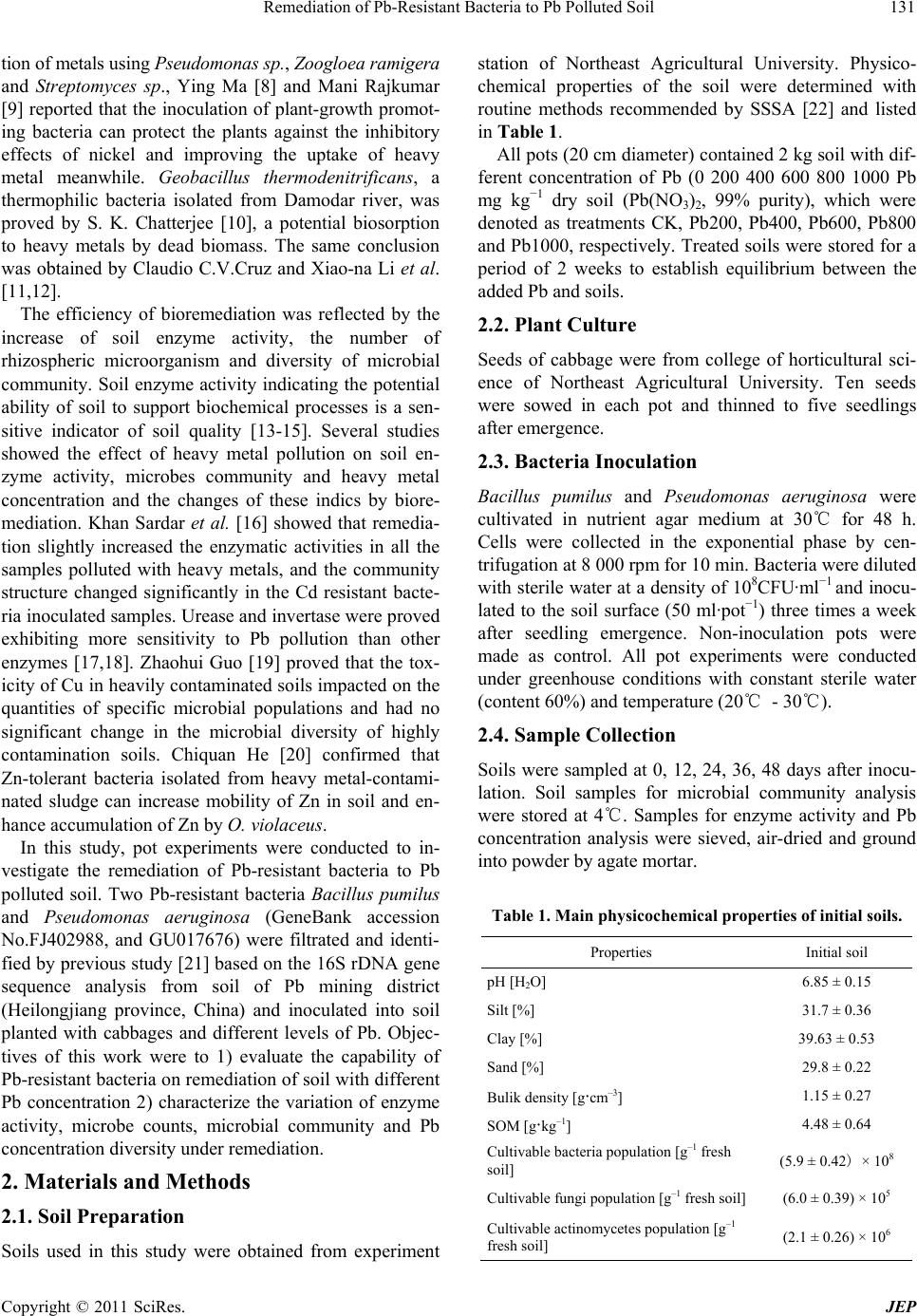 Remediation of Pb-Resistant Bacteria to Pb Polluted Soil131 tion of metals using Pseudomonas sp., Zoogloea ramigera and Streptomyces sp., Ying Ma [8] and Mani Rajkumar [9] reported that the inoculation of plant-growth promot- ing bacteria can protect the plants against the inhibitory effects of nickel and improving the uptake of heavy metal meanwhile. Geobacillus thermodenitrificans, a thermophilic bacteria isolated from Damodar river, was proved by S. K. Chatterjee [10], a potential biosorption to heavy metals by dead biomass. The same conclusion was obtained by Claudio C.V.Cruz and Xiao-na Li et al. [11,12]. The efficiency of bioremediation was reflected by the increase of soil enzyme activity, the number of rhizospheric microorganism and diversity of microbial community. Soil enzyme activity indicating the potential ability of soil to support biochemical processes is a sen- sitive indicator of soil quality [13-15]. Several studies showed the effect of heavy metal pollution on soil en- zyme activity, microbes community and heavy metal concentration and the changes of these indics by biore- mediation. Khan Sardar et al. [16] showed that remedia- tion slightly increased the enzymatic activities in all the samples polluted with heavy metals, and the community structure changed significantly in the Cd resistant bacte- ria inoculated samples. Urease and invertase were proved exhibiting more sensitivity to Pb pollution than other enzymes [17,18]. Zhaohui Guo [19] proved that the tox- icity of Cu in heavily contaminated soils impacted on the quantities of specific microbial populations and had no significant change in the microbial diversity of highly contamination soils. Chiquan He [20] confirmed that Zn-tolerant bacteria isolated from heavy metal-contami- nated sludge can increase mobility of Zn in soil and en- hance accumulation of Zn by O. violaceus. In this study, pot experiments were conducted to in- vestigate the remediation of Pb-resistant bacteria to Pb polluted soil. Two Pb-resistant bacteria Bacillus pumilus and Pseudomonas aeruginosa (GeneBank accession No.FJ402988, and GU017676) were filtrated and identi- fied by previous study [21] based on the 16S rDNA gene sequence analysis from soil of Pb mining district (Heilongjiang province, China) and inoculated into soil planted with cabbages and different levels of Pb. Objec- tives of this work were to 1) evaluate the capability of Pb-resistant bacteria on remediation of soil with different Pb concentration 2) characterize the variation of enzyme activity, microbe counts, microbial community and Pb concentration diversity under remediation. 2. Materials and Methods 2.1. Soil Preparation Soils used in this study were obtained from experiment station of Northeast Agricultural University. Physico- chemical properties of the soil were determined with routine methods recommended by SSSA [22] and listed in Table 1. All pots (20 cm diameter) contained 2 kg soil with dif- ferent concentration of Pb (0 200 400 600 800 1000 Pb mg kg−1 dry soil (Pb(NO3)2, 99% purity), which were denoted as treatments CK, Pb200, Pb400, Pb600, Pb800 and Pb1000, respectively. Treated soils were stored for a period of 2 weeks to establish equilibrium between the added Pb and soils. 2.2. Plant Culture Seeds of cabbage were from college of horticultural sci- ence of Northeast Agricultural University. Ten seeds were sowed in each pot and thinned to five seedlings after emergence. 2.3. Bacteria Inoculation Bacillus pumilus and Pseudomonas aeruginosa were cultivated in nutrient agar medium at 30℃ for 48 h. Cells were collected in the exponential phase by cen- trifugation at 8 000 rpm for 10 min. Bacteria were diluted with sterile water at a density of 108CFU·ml−1 and inocu- lated to the soil surface (50 ml·pot−1) three times a week after seedling emergence. Non-inoculation pots were made as control. All pot experiments were conducted under greenhouse conditions with constant sterile water (content 60%) and temperature (20℃ - 30℃). 2.4. Sample Collection Soils were sampled at 0, 12, 24, 36, 48 days after inocu- lation. Soil samples for microbial community analysis were stored at 4℃. Samples for enzyme activity and Pb concentration analysis were sieved, air-dried and ground into powder by agate mortar. Table 1. Main physicochemical properties of initial soils. Properties Initial soil pH [H2O] 6.85 ± 0.15 Silt [%] 31.7 ± 0.36 Clay [%] 39.63 ± 0.53 Sand [%] 29.8 ± 0.22 Bulik density [g·cm–3] 1.15 ± 0.27 SOM [g·kg–1] 4.48 ± 0.64 Cultivable bacteria population [g–1 fresh soil] (5.9 ± 0.42) × 108 Cultivable fungi population [g–1 fresh soil] (6.0 ± 0.39) × 105 Cultivable actinomycetes population [g–1 fresh soil] (2.1 ± 0.26) × 106 Copyright © 2011 SciRes. JEP 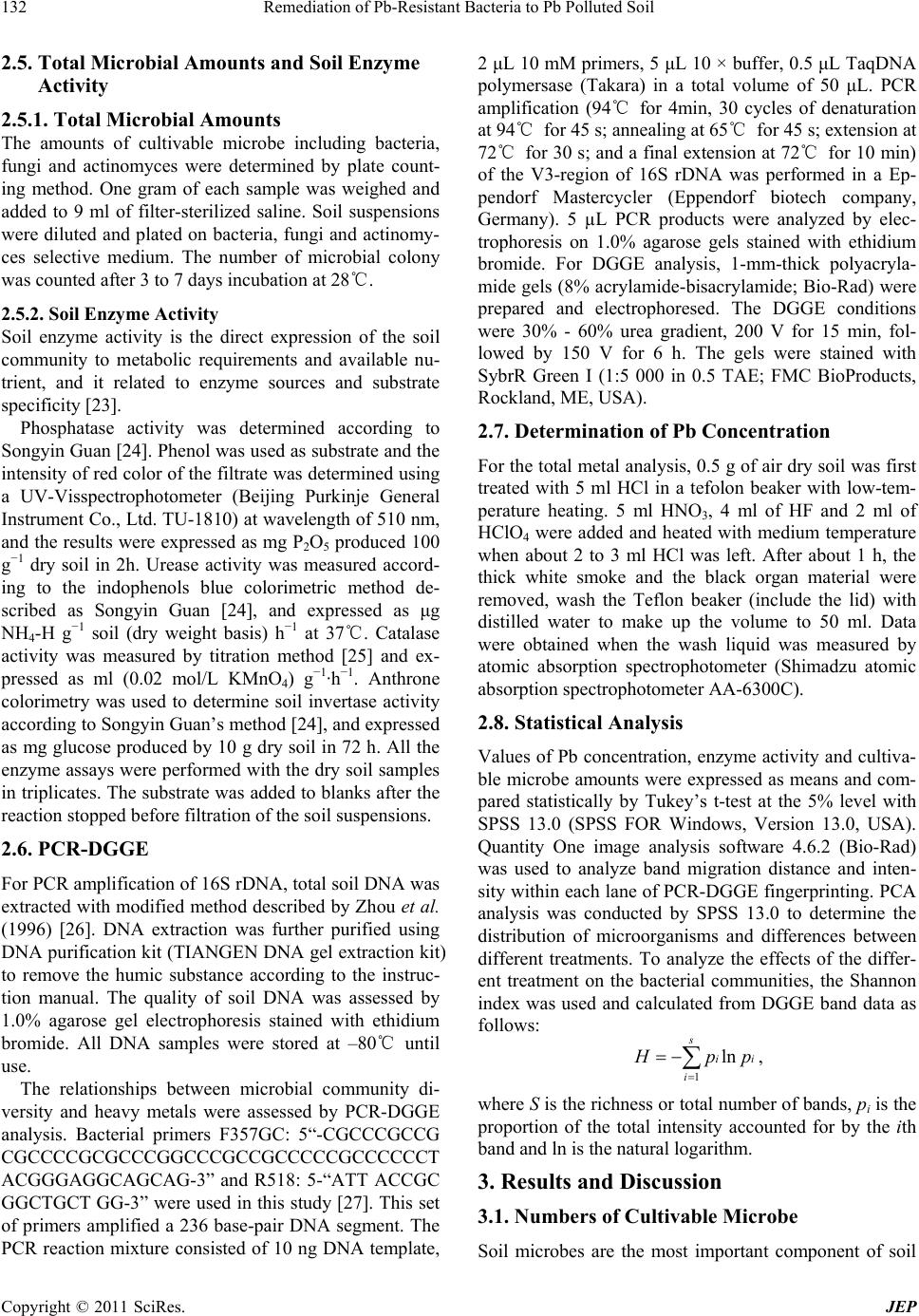 Remediation of Pb-Resistant Bacteria to Pb Polluted Soil 132 2.5. Total Microbial Amounts and Soil Enzyme Activity 2.5.1. Total Microbial Amounts The amounts of cultivable microbe including bacteria, fungi and actinomyces were determined by plate count- ing method. One gram of each sample was weighed and added to 9 ml of filter-sterilized saline. Soil suspensions were diluted and plated on bacteria, fungi and actinomy- ces selective medium. The number of microbial colony was counted after 3 to 7 days incubation at 28℃. 2.5.2. Soi l Enzyme Activity Soil enzyme activity is the direct expression of the soil community to metabolic requirements and available nu- trient, and it related to enzyme sources and substrate specificity [23]. Phosphatase activity was determined according to Songyin Guan [24]. Phenol was used as substrate and the intensity of red color of the filtrate was determined using a UV-Visspectrophotometer (Beijing Purkinje General Instrument Co., Ltd. TU-1810) at wavelength of 510 nm, and the results were expressed as mg P2O5 produced 100 g−1 dry soil in 2h. Urease activity was measured accord- ing to the indophenols blue colorimetric method de- scribed as Songyin Guan [24], and expressed as μg NH4-H g−1 soil (dry weight basis) h−1 at 37℃. Catalase activity was measured by titration method [25] and ex- pressed as ml (0.02 mol/L KMnO4) g−1·h−1. Anthrone colorimetry was used to determine soil invertase activity according to Songyin Guan’s method [24], and expressed as mg glucose produced by 10 g dry soil in 72 h. All the enzyme assays were performed with the dry soil samples in triplicates. The substrate was added to blanks after the reaction stopped before filtration of the soil suspensions. 2.6. PCR-DGGE For PCR amplification of 16S rDNA, total soil DNA was extracted with modified method described by Zhou et al. (1996) [26]. DNA extraction was further purified using DNA purification kit (TIANGEN DNA gel extraction kit) to remove the humic substance according to the instruc- tion manual. The quality of soil DNA was assessed by 1.0% agarose gel electrophoresis stained with ethidium bromide. All DNA samples were stored at –80℃ until use. The relationships between microbial community di- versity and heavy metals were assessed by PCR-DGGE analysis. Bacterial primers F357GC: 5“-CGCCCGCCG CGCCCCGCGCCCGGCCCGCCGCCCCCGCCCCCCT ACGGGAGGCAGCAG-3” and R518: 5-“ATT ACCGC GGCTGCT GG-3” were used in this study [27]. This set of primers amplified a 236 base-pair DNA segment. The PCR reaction mixture consisted of 10 ng DNA template, 2 μL 10 mM primers, 5 μL 10 × buffer, 0.5 μL TaqDNA polymersase (Takara) in a total volume of 50 μL. PCR amplification (94℃ for 4min, 30 cycles of denaturation at 94℃ for 45 s; annealing at 65℃ for 45 s; extension at 72℃ for 30 s; and a final extension at 72℃ for 10 min) of the V3-region of 16S rDNA was performed in a Ep- pendorf Mastercycler (Eppendorf biotech company, Germany). 5 µL PCR products were analyzed by elec- trophoresis on 1.0% agarose gels stained with ethidium bromide. For DGGE analysis, 1-mm-thick polyacryla- mide gels (8% acrylamide-bisacrylamide; Bio-Rad) were prepared and electrophoresed. The DGGE conditions were 30% - 60% urea gradient, 200 V for 15 min, fol- lowed by 150 V for 6 h. The gels were stained with SybrR Green I (1:5 000 in 0.5 TAE; FMC BioProducts, Rockland, ME, USA). 2.7. Determination of Pb Concentration For the total metal analysis, 0.5 g of air dry soil was first treated with 5 ml HCl in a tefolon beaker with low-tem- perature heating. 5 ml HNO3, 4 ml of HF and 2 ml of HClO4 were added and heated with medium temperature when about 2 to 3 ml HCl was left. After about 1 h, the thick white smoke and the black organ material were removed, wash the Teflon beaker (include the lid) with distilled water to make up the volume to 50 ml. Data were obtained when the wash liquid was measured by atomic absorption spectrophotometer (Shimadzu atomic absorption spectrophotometer AA-6300C). 2.8. Statistical Analysis Values of Pb concentration, enzyme activity and cultiva- ble microbe amounts were expressed as means and com- pared statistically by Tukey’s t-test at the 5% level with SPSS 13.0 (SPSS FOR Windows, Version 13.0, USA). Quantity One image analysis software 4.6.2 (Bio-Rad) was used to analyze band migration distance and inten- sity within each lane of PCR-DGGE fingerprinting. PCA analysis was conducted by SPSS 13.0 to determine the distribution of microorganisms and differences between different treatments. To analyze the effects of the differ- ent treatment on the bacterial communities, the Shannon index was used and calculated from DGGE band data as follows: 1 ln ii i pp , where S is the richness or total number of bands, pi is the proportion of the total intensity accounted for by the ith band and ln is the natural logarithm. 3. Results and Discussion 3.1. Numbers of Cultivable Microbe Soil microbes are the most important component of soil Copyright © 2011 SciRes. JEP 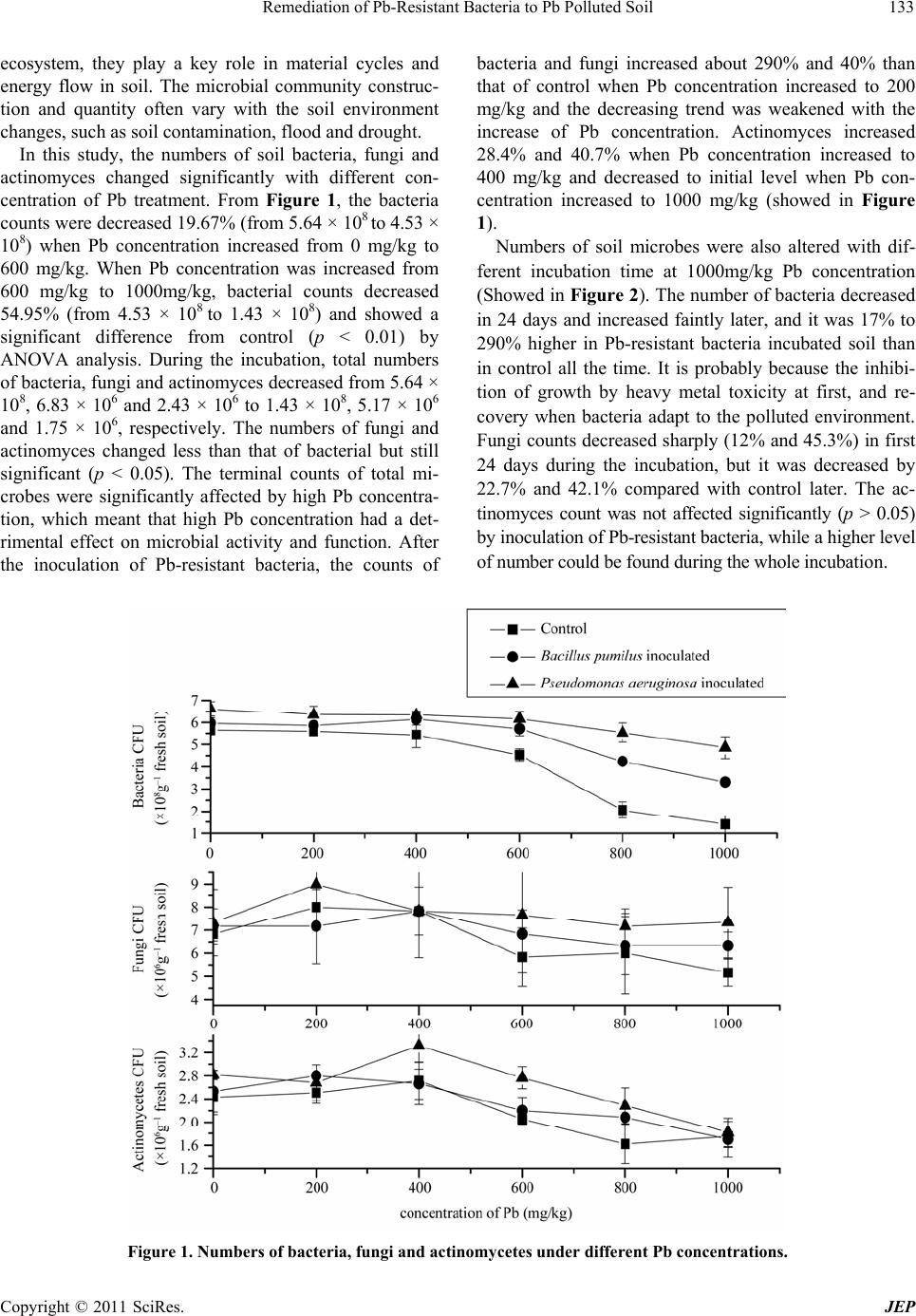 Remediation of Pb-Resistant Bacteria to Pb Polluted Soil Copyright © 2011 SciRes. JEP 133 ecosystem, they play a key role in material cycles and energy flow in soil. The microbial community construc- tion and quantity often vary with the soil environment changes, such as soil contamination, flood and drought. In this study, the numbers of soil bacteria, fungi and actinomyces changed significantly with different con- centration of Pb treatment. From Figure 1, the bacteria counts were decreased 19.67% (from 5.64 × 108 to 4.53 × 108) when Pb concentration increased from 0 mg/kg to 600 mg/kg. When Pb concentration was increased from 600 mg/kg to 1000mg/kg, bacterial counts decreased 54.95% (from 4.53 × 108 to 1.43 × 108) and showed a significant difference from control (p < 0.01) by ANOVA analysis. During the incubation, total numbers of bacteria, fungi and actinomyces decreased from 5.64 × 108, 6.83 × 106 and 2.43 × 106 to 1.43 × 108, 5.17 × 106 and 1.75 × 106, respectively. The numbers of fungi and actinomyces changed less than that of bacterial but still significant (p < 0.05). The terminal counts of total mi- crobes were significantly affected by high Pb concentra- tion, which meant that high Pb concentration had a det- rimental effect on microbial activity and function. After the inoculation of Pb-resistant bacteria, the counts of bacteria and fungi increased about 290% and 40% than that of control when Pb concentration increased to 200 mg/kg and the decreasing trend was weakened with the increase of Pb concentration. Actinomyces increased 28.4% and 40.7% when Pb concentration increased to 400 mg/kg and decreased to initial level when Pb con- centration increased to 1000 mg/kg (showed in Figure 1). Numbers of soil microbes were also altered with dif- ferent incubation time at 1000mg/kg Pb concentration (Showed in Figure 2). The number of bacteria decreased in 24 days and increased faintly later, and it was 17% to 290% higher in Pb-resistant bacteria incubated soil than in control all the time. It is probably because the inhibi- tion of growth by heavy metal toxicity at first, and re- covery when bacteria adapt to the polluted environment. Fungi counts decreased sharply (12% and 45.3%) in first 24 days during the incubation, but it was decreased by 22.7% and 42.1% compared with control later. The ac- tinomyces count was not affected significantly (p > 0.05) by inoculation of Pb-resistant bacteria, while a higher level of number could be found during the whole incubation. Figure 1. Numbers of bacteria, fungi and actinomyce te s under different Pb concentrations. 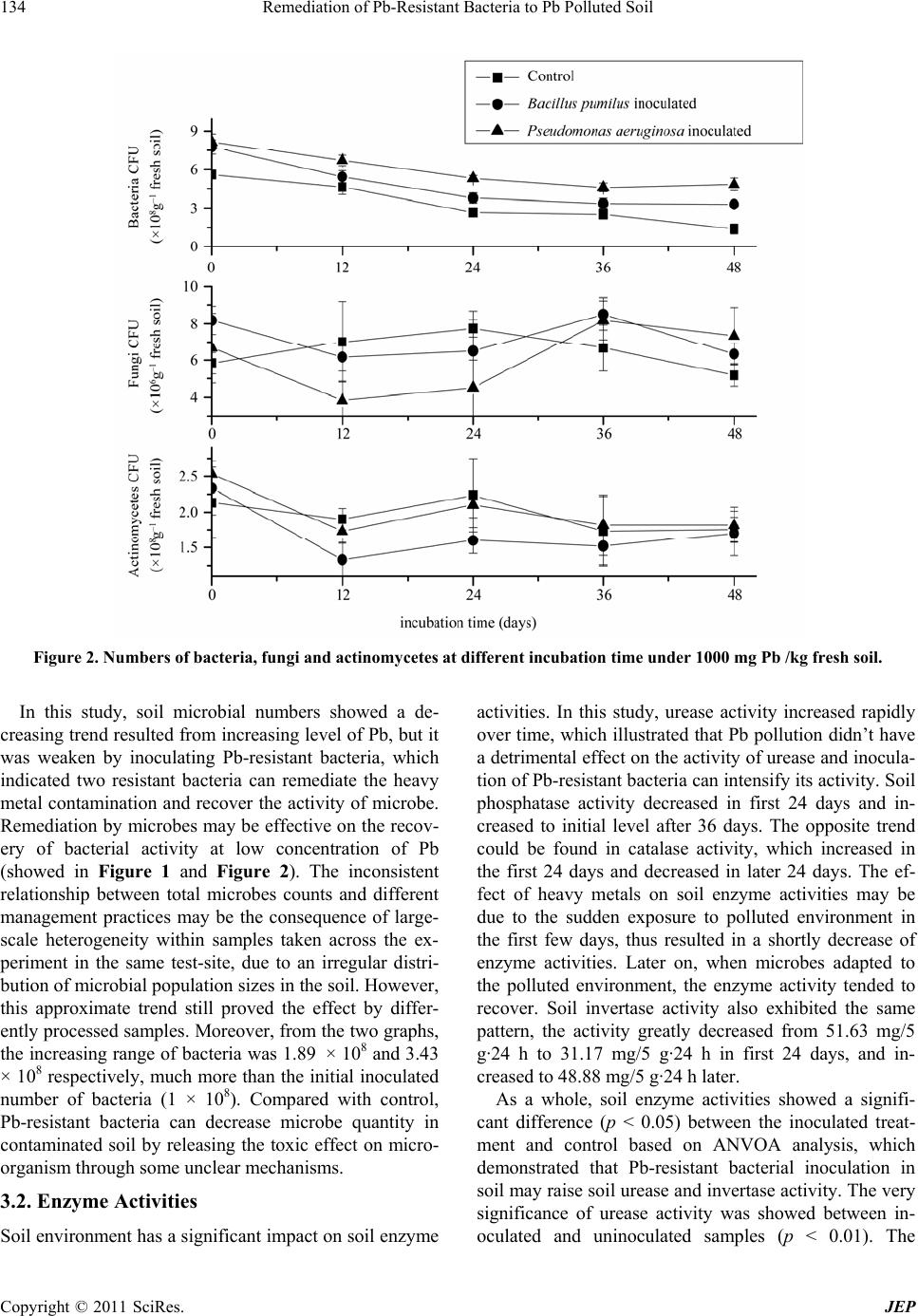 Remediation of Pb-Resistant Bacteria to Pb Polluted Soil 134 Figure 2. Numbers of bacteria, fungi and actinomycetes at different incubation time under 1000 mg Pb /kg fresh soil. In this study, soil microbial numbers showed a de- creasing trend resulted from increasing level of Pb, but it was weaken by inoculating Pb-resistant bacteria, which indicated two resistant bacteria can remediate the heavy metal contamination and recover the activity of microbe. Remediation by microbes may be effective on the recov- ery of bacterial activity at low concentration of Pb (showed in Figure 1 and Figure 2). The inconsistent relationship between total microbes counts and different management practices may be the consequence of large- scale heterogeneity within samples taken across the ex- periment in the same test-site, due to an irregular distri- bution of microbial population sizes in the soil. However, this approximate trend still proved the effect by differ- ently processed samples. Moreover, from the two graphs, the increasing range of bacteria was 1.89 × 108 and 3.43 × 108 respectively, much more than the initial inoculated number of bacteria (1 × 108). Compared with control, Pb-resistant bacteria can decrease microbe quantity in contaminated soil by releasing the toxic effect on micro- organism through some unclear mechanisms. 3.2. Enzyme Activities Soil environment has a significant impact on soil enzyme activities. In this study, urease activity increased rapidly over time, which illustrated that Pb pollution didn’t have a detrimental effect on the activity of urease and inocula- tion of Pb-resistant bacteria can intensify its activity. Soil phosphatase activity decreased in first 24 days and in- creased to initial level after 36 days. The opposite trend could be found in catalase activity, which increased in the first 24 days and decreased in later 24 days. The ef- fect of heavy metals on soil enzyme activities may be due to the sudden exposure to polluted environment in the first few days, thus resulted in a shortly decrease of enzyme activities. Later on, when microbes adapted to the polluted environment, the enzyme activity tended to recover. Soil invertase activity also exhibited the same pattern, the activity greatly decreased from 51.63 mg/5 g·24 h to 31.17 mg/5 g·24 h in first 24 days, and in- creased to 48.88 mg/5 g·24 h later. As a whole, soil enzyme activities showed a signifi- cant difference (p < 0.05) between the inoculated treat- ment and control based on ANVOA analysis, which demonstrated that Pb-resistant bacterial inoculation in soil may raise soil urease and invertase activity. The very significance of urease activity was showed between in- oculated and uninoculated samples (p < 0.01). The Copyright © 2011 SciRes. JEP 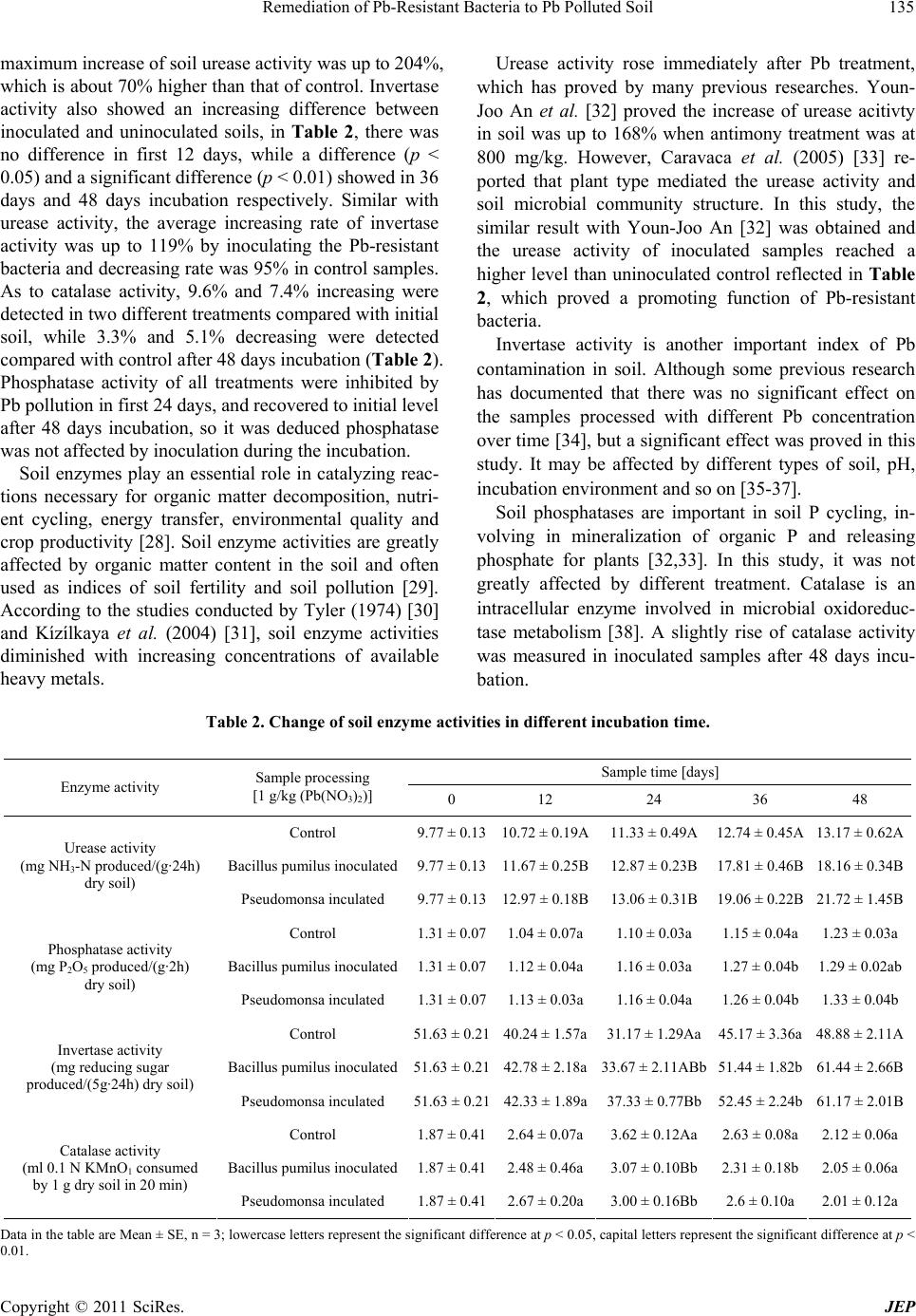 Remediation of Pb-Resistant Bacteria to Pb Polluted Soil135 maximum increase of soil urease activity was up to 204%, which is about 70% higher than that of control. Invertase activity also showed an increasing difference between inoculated and uninoculated soils, in Table 2, there was no difference in first 12 days, while a difference (p < 0.05) and a significant difference (p < 0.01) showed in 36 days and 48 days incubation respectively. Similar with urease activity, the average increasing rate of invertase activity was up to 119% by inoculating the Pb-resistant bacteria and decreasing rate was 95% in control samples. As to catalase activity, 9.6% and 7.4% increasing were detected in two different treatments compared with initial soil, while 3.3% and 5.1% decreasing were detected compared with control after 48 days incubation (Table 2). Phosphatase activity of all treatments were inhibited by Pb pollution in first 24 days, and recovered to initial level after 48 days incubation, so it was deduced phosphatase was not affected by inoculation during the incubation. Soil enzymes play an essential role in catalyzing reac- tions necessary for organic matter decomposition, nutri- ent cycling, energy transfer, environmental quality and crop productivity [28]. Soil enzyme activities are greatly affected by organic matter content in the soil and often used as indices of soil fertility and soil pollution [29]. According to the studies conducted by Tyler (1974) [30] and Kízílkaya et al. (2004) [31], soil enzyme activities diminished with increasing concentrations of available heavy metals. Urease activity rose immediately after Pb treatment, which has proved by many previous researches. Youn- Joo An et al. [32] proved the increase of urease acitivty in soil was up to 168% when antimony treatment was at 800 mg/kg. However, Caravaca et al. (2005) [33] re- ported that plant type mediated the urease activity and soil microbial community structure. In this study, the similar result with Youn-Joo An [32] was obtained and the urease activity of inoculated samples reached a higher level than uninoculated control reflected in Table 2, which proved a promoting function of Pb-resistant bacteria. Invertase activity is another important index of Pb contamination in soil. Although some previous research has documented that there was no significant effect on the samples processed with different Pb concentration over time [34], but a significant effect was proved in this study. It may be affected by different types of soil, pH, incubation environment and so on [35-37]. Soil phosphatases are important in soil P cycling, in- volving in mineralization of organic P and releasing phosphate for plants [32,33]. In this study, it was not greatly affected by different treatment. Catalase is an intracellular enzyme involved in microbial oxidoreduc- tase metabolism [38]. A slightly rise of catalase activity was measured in inoculated samples after 48 days incu- bation. Table 2. Change of soil enzyme activities in different incubation time. Sample time [days] Enzyme activity Sample processing [1 g/kg (Pb(NO3)2)] 0 12 24 36 48 Control 9.77 ± 0.1310.72 ± 0.19A11.33 ± 0.49A 12.74 ± 0.45A 13.17 ± 0.62A Bacillus pumilus inoculated9.77 ± 0.1311.67 ± 0.25B12.87 ± 0.23B 17.81 ± 0.46B 18.16 ± 0.34B Urease activity (mg NH3-N produced/(g·24h) dry soil) Pseudomonsa inculated 9.77 ± 0.1312.97 ± 0.18B13.06 ± 0.31B 19.06 ± 0.22B 21.72 ± 1.45B Control 1.31 ± 0.071.04 ± 0.07a1.10 ± 0.03a 1.15 ± 0.04a 1.23 ± 0.03a Bacillus pumilus inoculated1.31 ± 0.071.12 ± 0.04a1.16 ± 0.03a 1.27 ± 0.04b 1.29 ± 0.02ab Phosphatase activity (mg P2O5 produced/(g·2h) dry soil) Pseudomonsa inculated 1.31 ± 0.071.13 ± 0.03a1.16 ± 0.04a 1.26 ± 0.04b 1.33 ± 0.04b Control 51.63 ± 0.2140.24 ± 1.57a31.17 ± 1.29Aa 45.17 ± 3.36a 48.88 ± 2.11A Bacillus pumilus inoculated51.63 ± 0.2142.78 ± 2.18a33.67 ± 2.11ABb 51.44 ± 1.82b 61.44 ± 2.66B Invertase activity (mg reducing sugar produced/(5g·24h) dry soil) Pseudomonsa inculated 51.63 ± 0.2142.33 ± 1.89a37.33 ± 0.77Bb 52.45 ± 2.24b 61.17 ± 2.01B Control 1.87 ± 0.412.64 ± 0.07a3.62 ± 0.12Aa 2.63 ± 0.08a 2.12 ± 0.06a Bacillus pumilus inoculated1.87 ± 0.412.48 ± 0.46a3.07 ± 0.10Bb 2.31 ± 0.18b 2.05 ± 0.06a Catalase activity (ml 0.1 N KMnO1 consumed by 1 g dry soil in 20 min) Pseudomonsa inculated 1.87 ± 0.412.67 ± 0.20a3.00 ± 0.16Bb 2.6 ± 0.10a 2.01 ± 0.12a Data in the table are Mean ± SE, n = 3; lowercase letters represent the significant difference at p < 0.05, capital letters represent the significant difference at p < 0.01. Copyright © 2011 SciRes. JEP 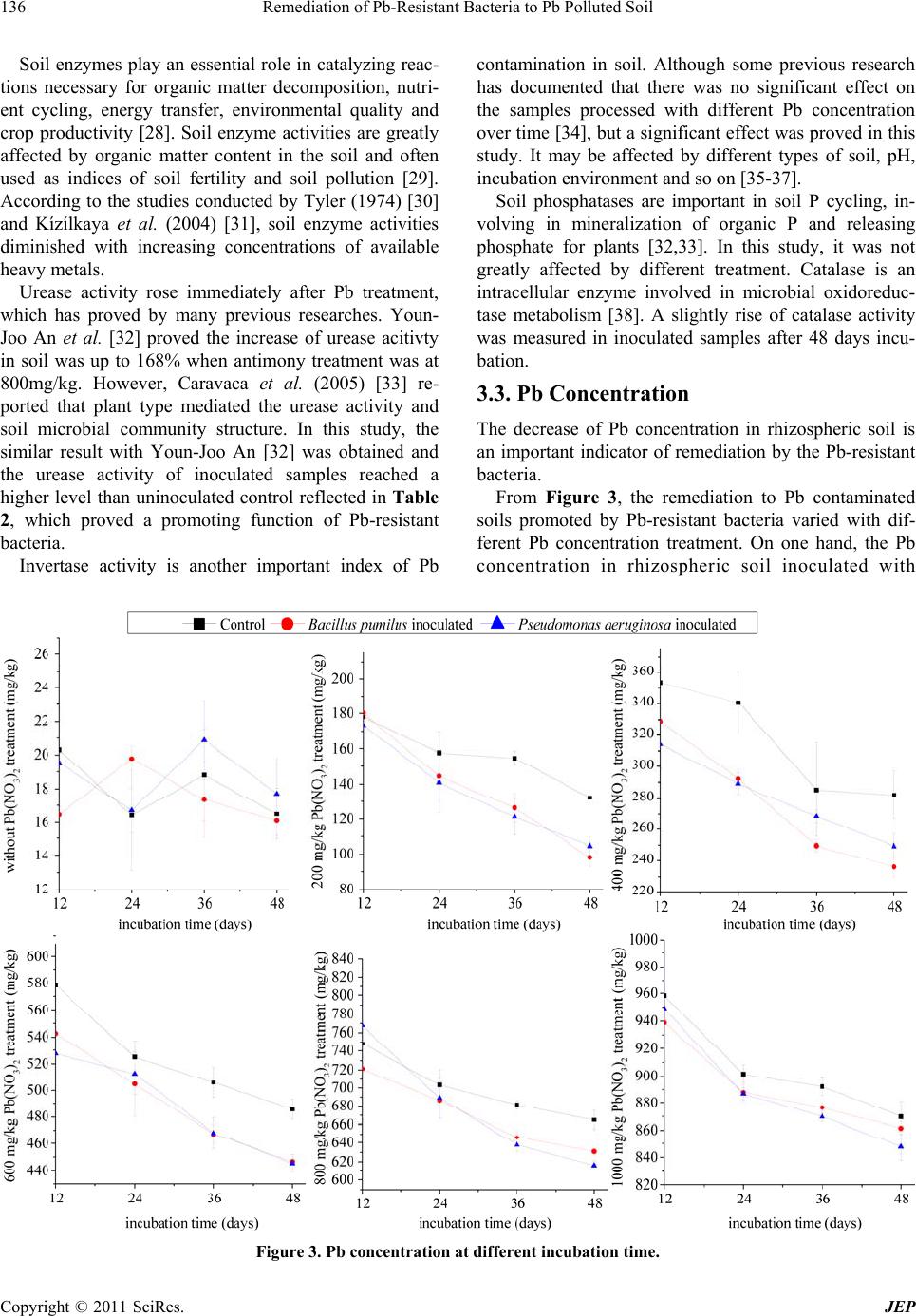 Remediation of Pb-Resistant Bacteria to Pb Polluted Soil 136 Soil enzymes play an essential role in catalyzing reac- tions necessary for organic matter decomposition, nutri- ent cycling, energy transfer, environmental quality and crop productivity [28]. Soil enzyme activities are greatly affected by organic matter content in the soil and often used as indices of soil fertility and soil pollution [29]. According to the studies conducted by Tyler (1974) [30] and Kízílkaya et al. (2004) [31], soil enzyme activities diminished with increasing concentrations of available heavy metals. Urease activity rose immediately after Pb treatment, which has proved by many previous researches. Youn- Joo An et al. [32] proved the increase of urease acitivty in soil was up to 168% when antimony treatment was at 800mg/kg. However, Caravaca et al. (2005) [33] re- ported that plant type mediated the urease activity and soil microbial community structure. In this study, the similar result with Youn-Joo An [32] was obtained and the urease activity of inoculated samples reached a higher level than uninoculated control reflected in Table 2, which proved a promoting function of Pb-resistant bacteria. Invertase activity is another important index of Pb contamination in soil. Although some previous research has documented that there was no significant effect on the samples processed with different Pb concentration over time [34], but a significant effect was proved in this study. It may be affected by different types of soil, pH, incubation environment and so on [35-37]. Soil phosphatases are important in soil P cycling, in- volving in mineralization of organic P and releasing phosphate for plants [32,33]. In this study, it was not greatly affected by different treatment. Catalase is an intracellular enzyme involved in microbial oxidoreduc- tase metabolism [38]. A slightly rise of catalase activity was measured in inoculated samples after 48 days incu- bation. 3.3. Pb Concentration The decrease of Pb concentration in rhizospheric soil is an important indicator of remediation by the Pb-resistant bacteria. From Figure 3, the remediation to Pb contaminated soils promoted by Pb-resistant bacteria varied with dif- ferent Pb concentration treatment. On one hand, the Pb concentration in rhizospheric soil inoculated with Figure 3. Pb concentration at different incubation time. Copyright © 2011 SciRes. JEP 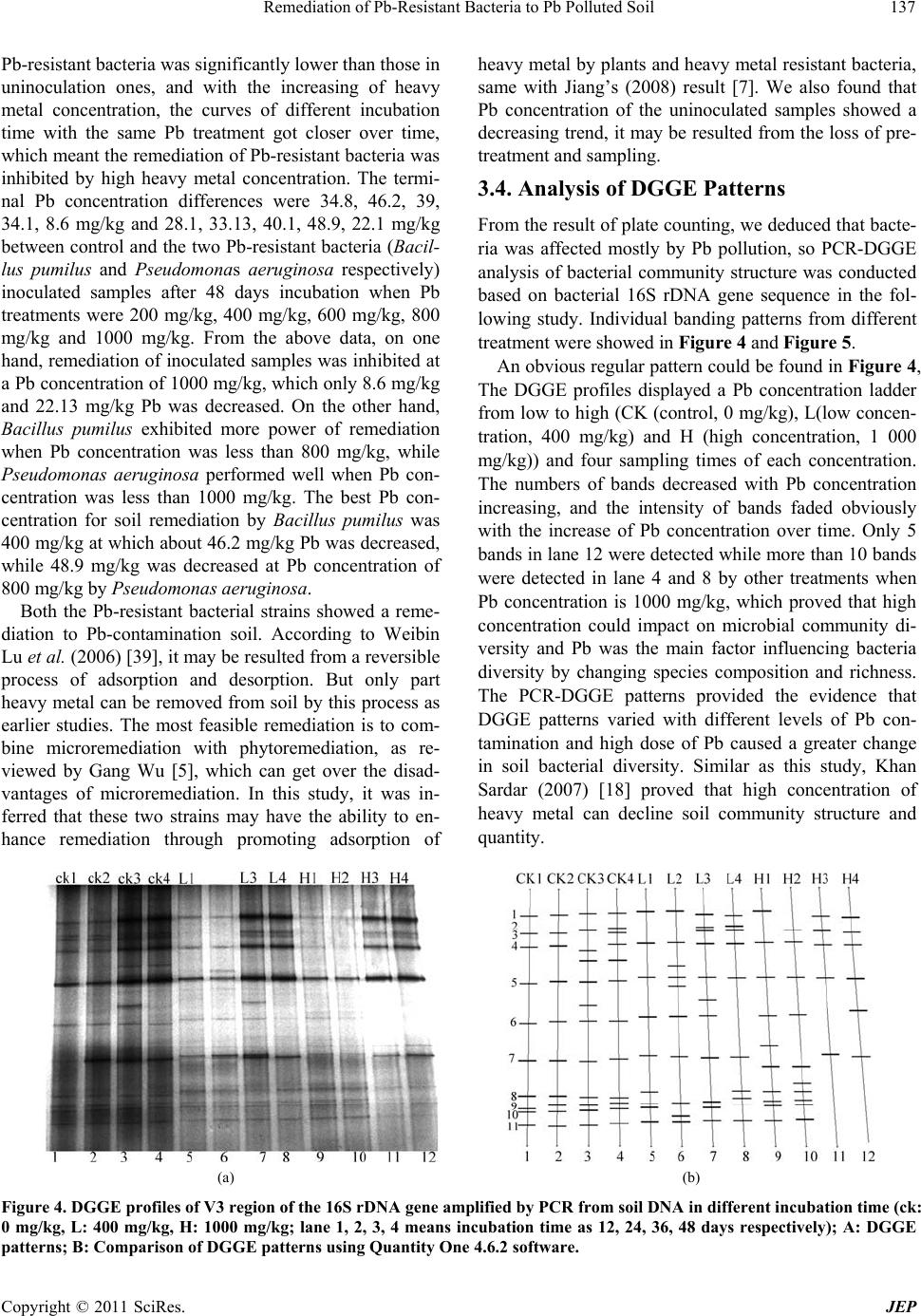 Remediation of Pb-Resistant Bacteria to Pb Polluted Soil137 Pb-resistant bacteria was significantly lower than those in uninoculation ones, and with the increasing of heavy metal concentration, the curves of different incubation time with the same Pb treatment got closer over time, which meant the remediation of Pb-resistant bacteria was inhibited by high heavy metal concentration. The termi- nal Pb concentration differences were 34.8, 46.2, 39, 34.1, 8.6 mg/kg and 28.1, 33.13, 40.1, 48.9, 22.1 mg/kg between control and the two Pb-resistant bacteria (Bacil- lus pumilus and Pseudomonas aeruginosa respectively) inoculated samples after 48 days incubation when Pb treatments were 200 mg/kg, 400 mg/kg, 600 mg/kg, 800 mg/kg and 1000 mg/kg. From the above data, on one hand, remediation of inoculated samples was inhibited at a Pb concentration of 1000 mg/kg, which only 8.6 mg/kg and 22.13 mg/kg Pb was decreased. On the other hand, Bacillus pumilus exhibited more power of remediation when Pb concentration was less than 800 mg/kg, while Pseudomonas aeruginosa performed well when Pb con- centration was less than 1000 mg/kg. The best Pb con- centration for soil remediation by Bacillus pumilus was 400 mg/kg at which about 46.2 mg/kg Pb was decreased, while 48.9 mg/kg was decreased at Pb concentration of 800 mg/kg by Pseudom onas aeruginosa. Both the Pb-resistant bacterial strains showed a reme- diation to Pb-contamination soil. According to Weibin Lu et al. (2006) [39], it may be resulted from a reversible process of adsorption and desorption. But only part heavy metal can be removed from soil by this process as earlier studies. The most feasible remediation is to com- bine microremediation with phytoremediation, as re- viewed by Gang Wu [5], which can get over the disad- vantages of microremediation. In this study, it was in- ferred that these two strains may have the ability to en- hance remediation through promoting adsorption of heavy metal by plants and heavy metal resistant bacteria, same with Jiang’s (2008) result [7]. We also found that Pb concentration of the uninoculated samples showed a decreasing trend, it may be resulted from the loss of pre- treatment and sampling. 3.4. Analysis of DGGE Patterns From the result of plate counting, we deduced that bacte- ria was affected mostly by Pb pollution, so PCR-DGGE analysis of bacterial community structure was conducted based on bacterial 16S rDNA gene sequence in the fol- lowing study. Individual banding patterns from different treatment were showed in Figure 4 and Figure 5. An obvious regular pattern could be found in Figure 4, The DGGE profiles displayed a Pb concentration ladder from low to high (CK (control, 0 mg/kg), L(low concen- tration, 400 mg/kg) and H (high concentration, 1 000 mg/kg)) and four sampling times of each concentration. The numbers of bands decreased with Pb concentration increasing, and the intensity of bands faded obviously with the increase of Pb concentration over time. Only 5 bands in lane 12 were detected while more than 10 bands were detected in lane 4 and 8 by other treatments when Pb concentration is 1000 mg/kg, which proved that high concentration could impact on microbial community di- versity and Pb was the main factor influencing bacteria diversity by changing species composition and richness. The PCR-DGGE patterns provided the evidence that DGGE patterns varied with different levels of Pb con- tamination and high dose of Pb caused a greater change in soil bacterial diversity. Similar as this study, Khan Sardar (2007) [18] proved that high concentration of heavy metal can decline soil community structure and quantity. (a) (b) Figure 4. DGGE profiles of V3 region of the 16S rDNA gene amplified by PCR from soil DNA in different incubation time (ck: 0 mg/kg, L: 400 mg/kg, H: 1000 mg/kg; lane 1, 2, 3, 4 means incubation time as 12, 24, 36, 48 days respectively); A: DGGE patterns; B: Comparison of DGGE patterns using Quantity One 4.6.2 software. Copyright © 2011 SciRes. JEP 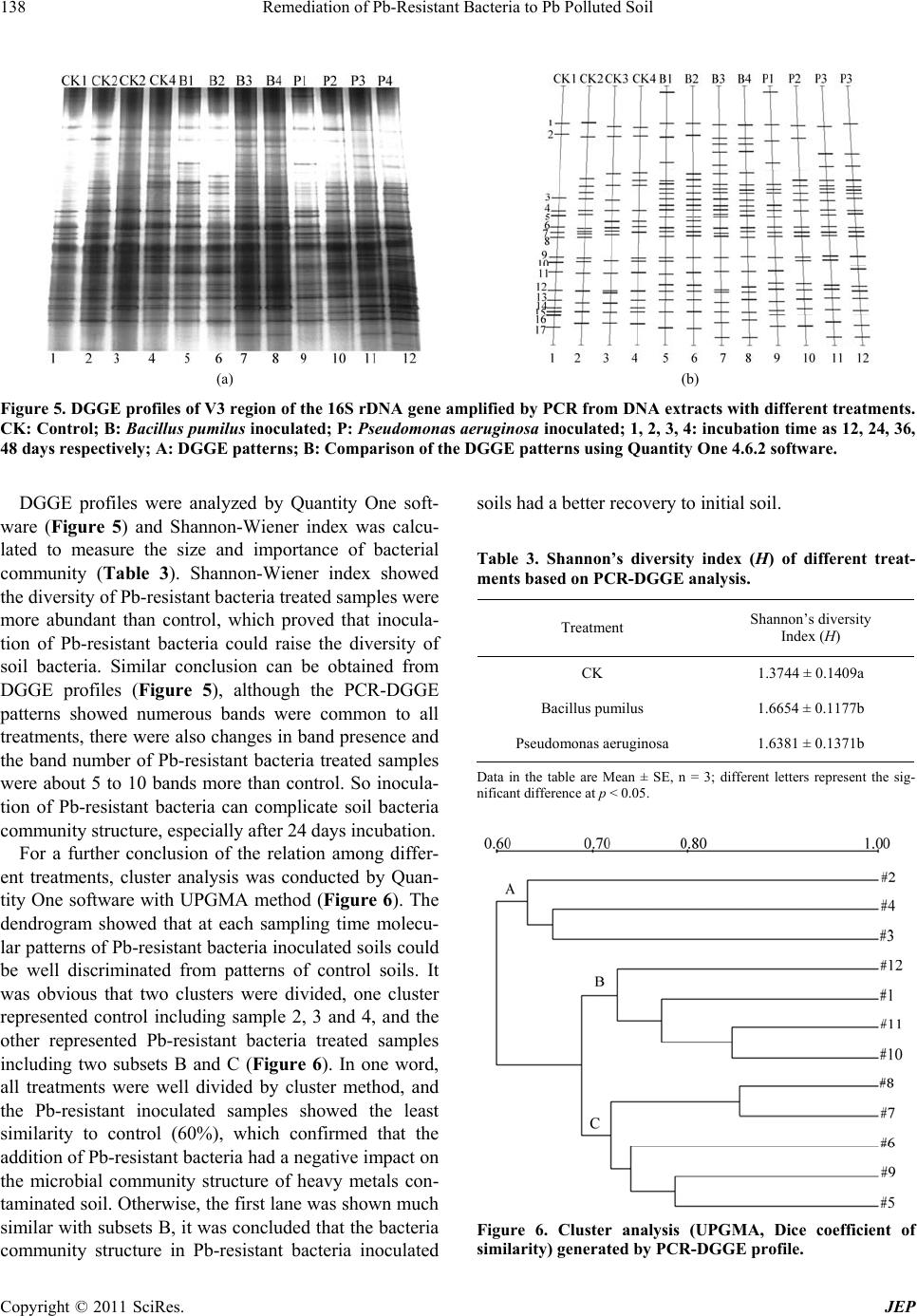 Remediation of Pb-Resistant Bacteria to Pb Polluted Soil 138 (a) (b) Figure 5. DGGE profiles of V3 region of the 16S rDNA gene amplified by PCR from DNA extracts with different treatments. CK: Control; B: Bacillus pumilus inoculated; P: Pseudomonas aeruginosa inoculated; 1, 2, 3, 4: incubation time as 12, 24, 36, 48 days respectively; A: DGGE patterns; B: Comparison of the DGGE patterns using Quantity One 4.6.2 software. DGGE profiles were analyzed by Quantity One soft- ware (Figure 5) and Shannon-Wiener index was calcu- lated to measure the size and importance of bacterial community (Table 3). Shannon-Wiener index showed the diversity of Pb-resistant bacteria treated samples were more abundant than control, which proved that inocula- tion of Pb-resistant bacteria could raise the diversity of soil bacteria. Similar conclusion can be obtained from DGGE profiles (Figure 5), although the PCR-DGGE patterns showed numerous bands were common to all treatments, there were also changes in band presence and the band number of Pb-resistant bacteria treated samples were about 5 to 10 bands more than control. So inocula- tion of Pb-resistant bacteria can complicate soil bacteria community structure, especially after 24 days incubation. For a further conclusion of the relation among differ- ent treatments, cluster analysis was conducted by Quan- tity One software with UPGMA method (Figure 6). The dendrogram showed that at each sampling time molecu- lar patterns of Pb-resistant bacteria inoculated soils could be well discriminated from patterns of control soils. It was obvious that two clusters were divided, one cluster represented control including sample 2, 3 and 4, and the other represented Pb-resistant bacteria treated samples including two subsets B and C (Figure 6). In one word, all treatments were well divided by cluster method, and the Pb-resistant inoculated samples showed the least similarity to control (60%), which confirmed that the addition of Pb-resistant bacteria had a negative impact on the microbial community structure of heavy metals con- taminated soil. Otherwise, the first lane was shown much similar with subsets B, it was concluded that the bacteria community structure in Pb-resistant bacteria inoculated soils had a better recovery to initial soil. Table 3. Shannon’s diversity index (H) of different treat- ments based on PCR-DGGE analysis. Treatment Shannon’s diversity Index (H) CK 1.3744 ± 0.1409a Bacillus pumilus 1.6654 ± 0.1177b Pseudomonas aeruginosa 1.6381 ± 0.1371b Data in the table are Mean ± SE, n = 3; different letters represent the sig- nificant difference at p < 0.05. Figure 6. Cluster analysis (UPGMA, Dice coefficient of similarity) generated by PCR-DGGE profile. Copyright © 2011 SciRes. JEP 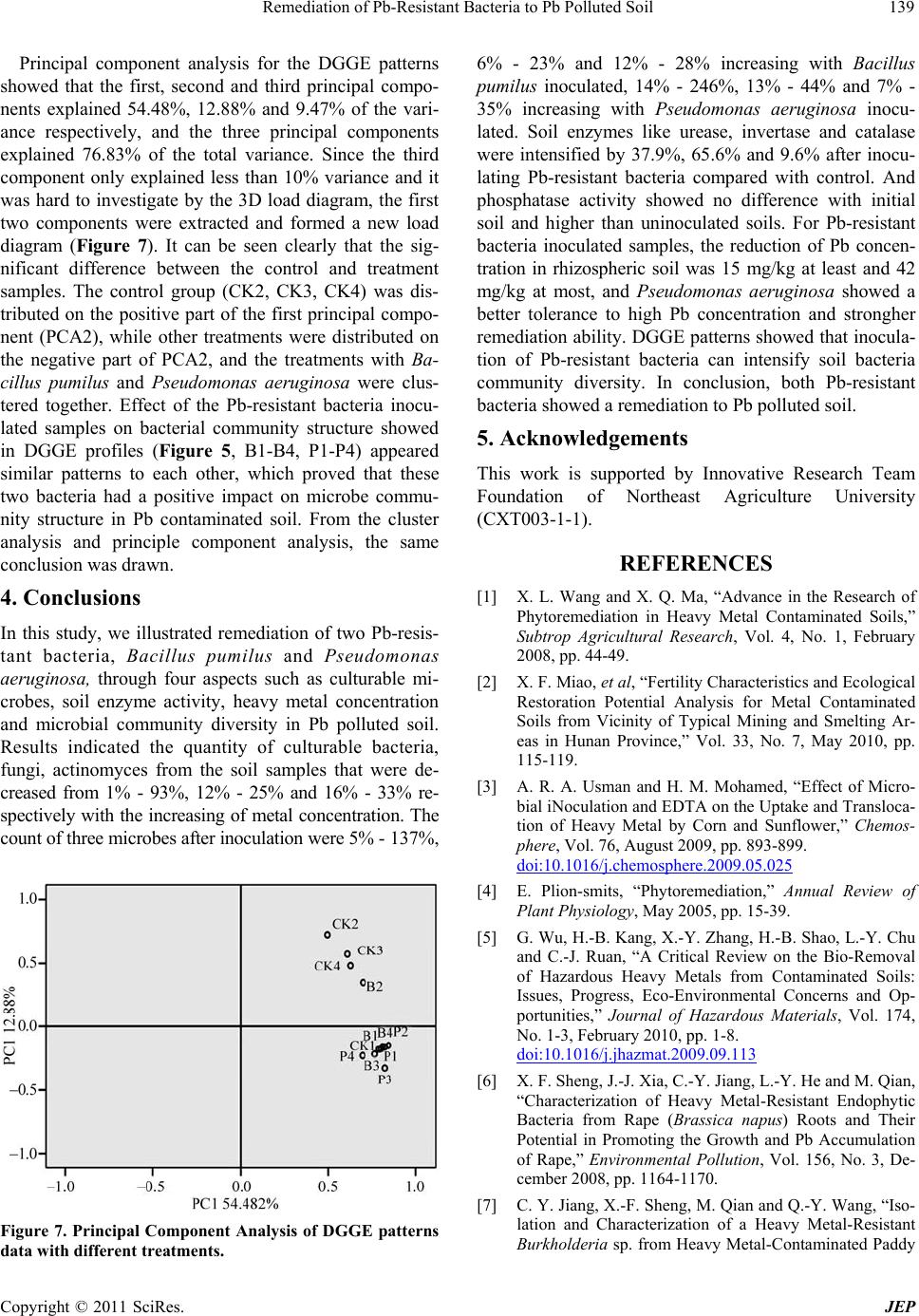 Remediation of Pb-Resistant Bacteria to Pb Polluted Soil139 Principal component analysis for the DGGE patterns showed that the first, second and third principal compo- nents explained 54.48%, 12.88% and 9.47% of the vari- ance respectively, and the three principal components explained 76.83% of the total variance. Since the third component only explained less than 10% variance and it was hard to investigate by the 3D load diagram, the first two components were extracted and formed a new load diagram (Figure 7). It can be seen clearly that the sig- nificant difference between the control and treatment samples. The control group (CK2, CK3, CK4) was dis- tributed on the positive part of the first principal compo- nent (PCA2), while other treatments were distributed on the negative part of PCA2, and the treatments with Ba- cillus pumilus and Pseudomonas aeruginosa were clus- tered together. Effect of the Pb-resistant bacteria inocu- lated samples on bacterial community structure showed in DGGE profiles (Figure 5, B1-B4, P1-P4) appeared similar patterns to each other, which proved that these two bacteria had a positive impact on microbe commu- nity structure in Pb contaminated soil. From the cluster analysis and principle component analysis, the same conclusion was drawn. 4. Conclusions In this study, we illustrated remediation of two Pb-resis- tant bacteria, Bacillus pumilus and Pseudomonas aeruginosa, through four aspects such as culturable mi- crobes, soil enzyme activity, heavy metal concentration and microbial community diversity in Pb polluted soil. Results indicated the quantity of culturable bacteria, fungi, actinomyces from the soil samples that were de- creased from 1% - 93%, 12% - 25% and 16% - 33% re- spectively with the increasing of metal concentration. The count of three microbes after inoculation were 5% - 137%, Figure 7. Principal Component Analysis of DGGE patterns data with different treatments. 6% - 23% and 12% - 28% increasing with Bacillus pumilus inoculated, 14% - 246%, 13% - 44% and 7% - 35% increasing with Pseudomonas aeruginosa inocu- lated. Soil enzymes like urease, invertase and catalase were intensified by 37.9%, 65.6% and 9.6% after inocu- lating Pb-resistant bacteria compared with control. And phosphatase activity showed no difference with initial soil and higher than uninoculated soils. For Pb-resistant bacteria inoculated samples, the reduction of Pb concen- tration in rhizospheric soil was 15 mg/kg at least and 42 mg/kg at most, and Pseudomonas aeruginosa showed a better tolerance to high Pb concentration and strongher remediation ability. DGGE patterns showed that inocula- tion of Pb-resistant bacteria can intensify soil bacteria community diversity. In conclusion, both Pb-resistant bacteria showed a remediation to Pb polluted soil. 5. Acknowledgements This work is supported by Innovative Research Team Foundation of Northeast Agriculture University (CXT003-1-1). REFERENCES [1] X. L. Wang and X. Q. Ma, “Advance in the Research of Phytoremediation in Heavy Metal Contaminated Soils,” Subtrop Agricultural Research, Vol. 4, No. 1, February 2008, pp. 44-49. [2] X. F. Miao, et al, “Fertility Characteristics and Ecological Restoration Potential Analysis for Metal Contaminated Soils from Vicinity of Typical Mining and Smelting Ar- eas in Hunan Province,” Vol. 33, No. 7, May 2010, pp. 115-119. [3] A. R. A. Usman and H. M. Mohamed, “Effect of Micro- bial iNoculation and EDTA on the Uptake and Transloca- tion of Heavy Metal by Corn and Sunflower,” Chemos- phere, Vol. 76, August 2009, pp. 893-899. doi:10.1016/j.chemosphere.2009.05.025 [4] E. Plion-smits, “Phytoremediation,” Annual Review of Plant Physiology, May 2005, pp. 15-39. [5] G. Wu, H.-B. Kang, X.-Y. Zhang, H.-B. Shao, L.-Y. Chu and C.-J. Ruan, “A Critical Review on the Bio-Removal of Hazardous Heavy Metals from Contaminated Soils: Issues, Progress, Eco-Environmental Concerns and Op- portunities,” Journal of Hazardous Materials, Vol. 174, No. 1-3, February 2010, pp. 1-8. doi:10.1016/j.jhazmat.2009.09.113 [6] X. F. Sheng, J.-J. Xia, C.-Y. Jiang, L.-Y. He and M. Qian, “Characterization of Heavy Metal-Resistant Endophytic Bacteria from Rape (Brassica napus) Roots and Their Potential in Promoting the Growth and Pb Accumulation of Rape,” Environmental Pollution, Vol. 156, No. 3, De- cember 2008, pp. 1164-1170. [7] C. Y. Jiang, X.-F. Sheng, M. Qian and Q.-Y. Wang, “Iso- lation and Characterization of a Heavy Metal-Resistant Burkholderia sp. from Heavy Metal-Contaminated Paddy Copyright © 2011 SciRes. JEP  Remediation of Pb-Resistant Bacteria to Pb Polluted Soil 140 Field Soil and Its Potential in Promoting Plant Growth and Heavy Metal Accumulation in Metal-Polluted Soil,” Chemosphere, Vol. 72, No. 2, May 2008, pp. 157-164. doi:10.1016/j.chemosphere.2008.02.006 [8] Y. Ma, M. Rajkumar and H. Freitas, “Improvement of Plant Growth and Nickel Uptake by Nickel Resistant- Plant-Growth Promoting Bacteria,” Journal of Hazardous Materials, Vol. 166, No. 2-3, July 2009, pp. 1154-1161. doi:10.1016/j.jhazmat.2008.12.018 [9] M. Rajkumar and H. Freitas, “Effects of iNoculation of Plant-Growth Promoting Bacteria on Ni Uptake by Indian mustard,” Bioresource TechNology, Vol. 99, No. 9, June 2008, pp. 3491-3498. doi:10.1016/j.biortech.2007.07.046 [10] S. K. Chatterjee, I. Bhattacharjee and C. Chandra, “Bio- sorption of Heavy Metals from Industrial Waste Water by Geobacillus Thermodenitrificans,” Journal of Hazardous Materials, Vol. 175, No. 1-3, March 2010, pp. 117-125. doi:10.1016/j.jhazmat.2009.09.136 [11] C. C. V. Cruz and A. C. A. da Costa, “Kinetic Modeling and Equilibrium Studies during Cadmium Biosorption by Dead Sargassum sp. Biomass,” Bioresource TechNology, Vol. 91, No. 3, February 2004, pp. 249-257. doi:10.1016/S0960-8524(03)00194-9 [12] X. N. Li, Q.-Y. Xu, G.-M. Han, “Equilibrium and Kinetic Studies of Copper (Ⅱ) Removal by Three Species of Dead Fungal Biomasses,” Journal of Hazardous Materi- als, Vol. 165, No. 1-3, October 2008, pp. 469-474. [13] M. Brzezinska, Z. Stepniewska and W. Stepniewski, “Soil Oxygen Status and Dehydrogenase Activity,” Soil Biology and Biochemistry, Vol. 30, No. 13, November 1998, pp. 1783-1790. doi:10.1016/S0038-0717(98)00043-1 [14] D. C. Naseby and J. M. Lynch, “Rhizosphere Soil En- zymes as Indicators of Perturbations Caused by Enzyme Substrate Addition and iNoculation of a Genetically Modified Strain of Pseudomonas Fluorescens on Wheat Seed,” Soil Biology and Biochemistry, Vol. 29, No. 9-10, September 1997, pp. 1353-1362. doi:10.1016/S0038-0717(97)00061-8 [15] B. Brohon, C. Delolme and R. Gourdon, “Complementar- ity of Bioassays and Microbial Activity Measurements for the Evaluation of Hydrocarbon-Contaminated Soils Qual- ity,” Soil Biology and Biochemistry, Vol. 33, No. 7-8, June 2001, pp. 883-891. doi:10.1016/S0038-0717(00)00234-0 [16] I. Mijangos, R. Perez, I. Albizu and C. Garbisu, “Effects of Fertilization and Tillage on Soil Biological Parame- ters,” Enzyme and Microbial TechNology, Vol. 40, No. 1, December 2006, pp. 100-106. doi:10.1016/j.enzmictec.2005.10.043 [17] O. N. Belyaeva, R. J. Haynes and O. A. Birukova, “Bar- ley Yield and Soil Microbial and Enzyme Activities as Affected by Contamination of Two Soils with Pb, zinc or Copper,” Biology and Fertility of Soils, Vol. 41, No. 2, 2007, pp. 85-94. [18] S. Khan, Q. Cao, H. A. E.-L., Y. Xia and J. Z. He, “Soil Enzymatic Activities and Microbial Community Structure with Different Application Rates of Cd and Pb,” Journal of Environmental Sciences, Vol. 19, No. 7, 2007, pp. 834-840. doi:10.1016/S1001-0742(07)60139-9 [19] Z. H. Guo, M. Megharaj, M. Beer, H. Ming, M. M. Rah- man, W. H. Wu and R. Naidu, “Heavy Metal Impact on Bacterial Biomass Based on DNA Analyses and Uptake by Wild Plants in the Abandoned Copper Mine Soils,” Bioresource TechNology, Vol. 100, No. 17, September 2009, pp. 3831-3836. doi:10.1016/j.biortech.2009.02.043 [20] C. Q. He, G. E. Tan, X. Liang, W. Du, Y. L. Chen, G. Y. Zhi and Y. Zhu, “Effect of Zn-Tolerant Bacterial Strains on Growth and Zn Accumulation in Orychophragmus violaceus,” Applied Soil Ecology, Vol. 44, No.1, January 2010, pp. 1-5. doi:10.1016/j.apsoil.2009.07.003 [21] G. M. Ren and J. J. Qu, “Isolation and Biosorption Char- acteristics of Pb Resistant Bacterium,” Journal of North- east Agricultural University, Vol. 41, No. 2, February 2010, pp. 55-59. [22] D. L. Sparks, “Methods of Soil Analysis: Chemical Methods,” The Soil Science Society of America Book Series, SSSA, Madison, 1996, WI. [23] B. A. Caldwell, “Enzyme Activities as a Component of Soil Biodiversity: A Review,” Pedobiologia, Vol. 49, No. 6, November 2005, pp. 637-644. doi:10.1016/j.pedobi.2005.06.003 [24] S. Y. Guan, “Soil Enzyme Activities and Research Meth- ods,” China Agriculture Press, Beijing, 1986. [25] L. L. Zhou and Z. M Zhang, “The Determination Method of Soil Enzyme,” Chinese Journal of Soil Science, Vol. 11, No. 5, 1980, pp. 37-38. [26] J. Z. Zhou, A. B. Mary and J. M. Tiedje, “DNA Recovery from Soils of Diversity Composition,” Applied and Envi- ronmental Microbiology, Vol. 62, No. 2, February 1996, pp. 316-322. [27] L. Ovreas, L. Forney, F. L. Daae and V. Torsvik, “Dis- tribution of Bacterioplankton in Meriomictic Lake Saelenvannet, as Determined by Denaturing Gradient Gel Electrophoresis of PCR-Amplified Gene Fragments Coding for 16S rRNA,” Applied and Environmental Microbiology, Vol. 163, No. 9, September 1997, pp. 3367-3373. [28] R. P. Dick, “Soil Enzyme Activities as Indicators of Soil Quality,” In: J. W. Doran, D. C. Coleman, D. F. Bezdicek, B. A. Stewart, Eds., “Defining Soil Quality for a Sus- tainable Environment,” American Society of AgroNomy, Madison, WI, 1994, pp. 107-124. [29] R. P. Dick and M. A. Tabatabai, “Potential Uses of Soil Enzymes,” In: Jr., F. B. Metting, Ed., “Soil Microbial Ecology,” Applications in Agricultural and Environ- mental Management, Marcel Dekker, New York, 1992, pp. 95-127. [30] G. Tyler, “Heavy Metal Pollution and Soil Enzymatic Activity,” Plant and Soil, Vol. 41, 1974, pp. 303-311. doi:10.1007/BF00017258 [31] K. R, BayraklíB, “Effects of N-Enriched Sewage Sludge on Soil Enzyme Activities,” Applied Soil Ecology, Vol. 30, No. 3, November 2005, pp. 192-202. Copyright © 2011 SciRes. JEP 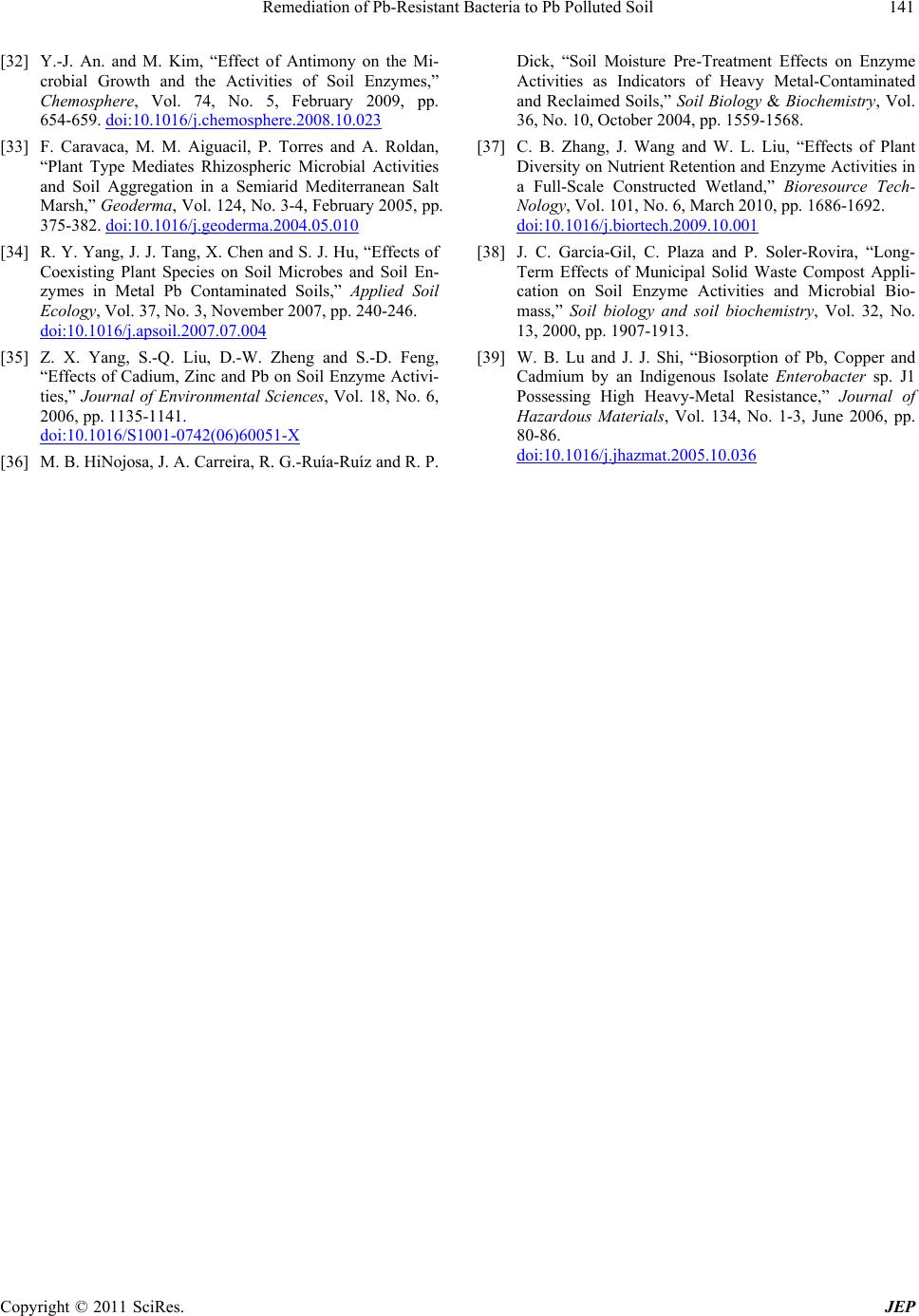 Remediation of Pb-Resistant Bacteria to Pb Polluted Soil Copyright © 2011 SciRes. JEP 141 [32] Y.-J. An. and M. Kim, “Effect of Antimony on the Mi- crobial Growth and the Activities of Soil Enzymes,” Chemosphere, Vol. 74, No. 5, February 2009, pp. 654-659. doi:10.1016/j.chemosphere.2008.10.023 [33] F. Caravaca, M. M. Aiguacil, P. Torres and A. Roldan, “Plant Type Mediates Rhizospheric Microbial Activities and Soil Aggregation in a Semiarid Mediterranean Salt Marsh,” Geoderma, Vol. 124, No. 3-4, February 2005, pp. 375-382. doi:10.1016/j.geoderma.2004.05.010 [34] R. Y. Yang, J. J. Tang, X. Chen and S. J. Hu, “Effects of Coexisting Plant Species on Soil Microbes and Soil En- zymes in Metal Pb Contaminated Soils,” Applied Soil Ecology, Vol. 37, No. 3, November 2007, pp. 240-246. doi:10.1016/j.apsoil.2007.07.004 [35] Z. X. Yang, S.-Q. Liu, D.-W. Zheng and S.-D. Feng, “Effects of Cadium, Zinc and Pb on Soil Enzyme Activi- ties,” Journal of Environmental Sciences, Vol. 18, No. 6, 2006, pp. 1135-1141. doi:10.1016/S1001-0742(06)60051-X [36] M. B. HiNojosa, J. A. Carreira, R. G.-Ruía-Ruíz and R. P. Dick, “Soil Moisture Pre-Treatment Effects on Enzyme Activities as Indicators of Heavy Metal-Contaminated and Reclaimed Soils,” Soil Biology & Biochemistry, Vol. 36, No. 10, October 2004, pp. 1559-1568. [37] C. B. Zhang, J. Wang and W. L. Liu, “Effects of Plant Diversity on Nutrient Retention and Enzyme Activities in a Full-Scale Constructed Wetland,” Bioresource Tech- Nology, Vol. 101, No. 6, March 2010, pp. 1686-1692. doi:10.1016/j.biortech.2009.10.001 [38] J. C. García-Gil, C. Plaza and P. Soler-Rovira, “Long- Term Effects of Municipal Solid Waste Compost Appli- cation on Soil Enzyme Activities and Microbial Bio- mass,” Soil biology and soil biochemistry, Vol. 32, No. 13, 2000, pp. 1907-1913. [39] W. B. Lu and J. J. Shi, “Biosorption of Pb, Copper and Cadmium by an Indigenous Isolate Enterobacter sp. J1 Possessing High Heavy-Metal Resistance,” Journal of Hazardous Materials, Vol. 134, No. 1-3, June 2006, pp. 80-86. doi:10.1016/j.jhazmat.2005.10.036
|